One of heptadecabillionaire Steve Cohen’s first acts as owner of the Mets was to give almost everyone a raise. This was not actually his idea. Team president Sandy Alderson had spent nearly eight years as the club’s GM before stepping back to deal with a recurrence of an unspecified form of cancer, and when Cohen brought him back in 2020 and promoted him, one of the first items on Alderson’s to-do list was a dollar sign.
Alderson had initially joined the Mets in 2010 as a suggestion by the commissioner’s office to lend stability to a franchise reeling from the collapse of Bernie Madoff’s Ponzi scheme; the trustee for the victims sued then owner and major Madoff investor Fred Wilpon for $1 billion, saying that he knew or should have known the returns were fraudulent. (Wilpon denied the allegations; in ’12, he settled for $162 million.) Wilpon had to take out $65 million in loans, including $25 million from MLB, just to make payroll.
He began cutting costs anywhere he could. He pulled scouts off the road; others were told to watch their expenses. Officials sent to evaluate the Red Sox joked that they would have to stay in Rhode Island. He slashed player salary by more than $50 million in 2012, the deepest gash in major league history. Amid the chaos, Alderson lost employees to higher-paying teams. He will never know how many promising candidates turned him down because the Mets lowballed them.
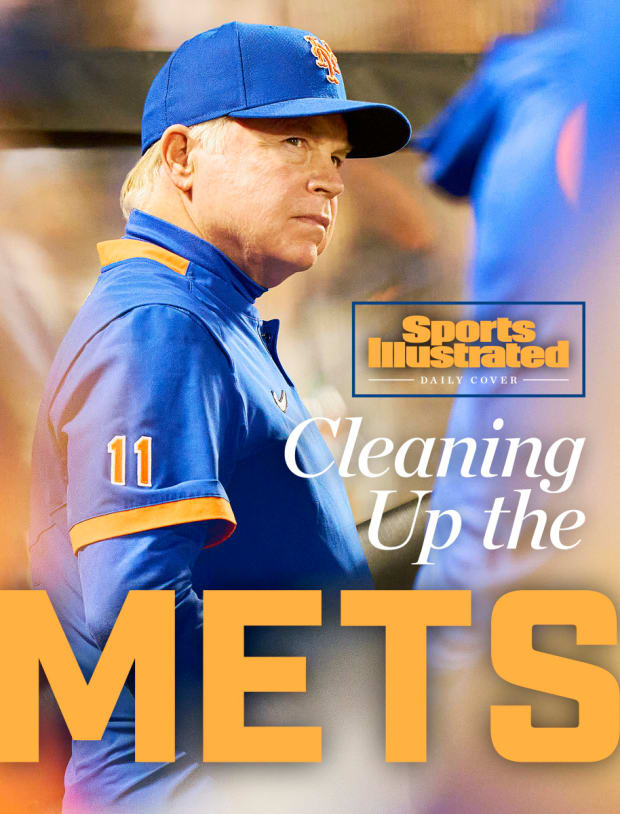
Erick W. Rasco/Sports Illustrated
Now he was back, tasked again with stabilizing the same wayward organization. In November 2020, Wilpon sold the team for $2.4 billion to Cohen, a hedge fund manager whose business practices made some of his fellow owners nervous: His first firm, SAC Capital Advisors, pleaded guilty in ’13 to criminal and civil charges of insider trading and paid a record $1.8 billion settlement. (Cohen was never personally charged with a crime, but as part of a U.S. Securities and Exchange Commission settlement in which he did not admit wrongdoing, he was barred from managing other people’s money for two years. When that period expired, the SEC approved him to resume operations. Some of the employees who were charged with crimes had their convictions overturned.) Cohen, a Mets minority owner since ’12, saw Alderson as a respected figure who would help legitimize his bid for majority control. (On Thursday the team announced that Alderson will move to an advisory role soon. “When I asked Sandy to come back to the team, it was for a defined period of time and with a specific mandate—revive our culture and this iconic franchise for our fans, partners and employees,” Cohen said in a statement. “Sandy has done those very things and more.”)
Fewer than 100 people in the world have accumulated more wealth than Cohen; Forbes estimates his net worth at $17.5 billion, some three times more than the next-richest MLB team owners. His peers were concerned enough about his disproportionate might to add an additional luxury-tax threshold—the so-called Cohen Tax—to last winter’s collective bargaining agreement. (“It’s better than having a bridge named after you,” the owner likes to joke.) The league has also capped spending in the draft and international amateur markets, meaning Cohen is somewhat limited in how much he can dispense to players.
But he can invest in them in other ways, so increasing staffers’ pay just seemed like good business. The team commissioned an industry-wide study in late 2020 and quickly realized Alderson’s suspicions were correct. The Mets decline to speak specifically about figures, but one person familiar with the outcome says that by the following spring, “the overwhelming majority” of employees had received a salary bump. Another person says, “I would say more than 50% of our player development staff significantly—significantly—got an increase that got them on the scale where they should be for their job title.” A third person says he knows of someone whose pay jumped 100%. Alderson refuses to take credit for the increases but says several people told him the raise had been “life-changing.”
Perhaps obviously, it also improved morale. “Lots of people are willing to do whatever it takes, including work for nothing or for a small amount to get their foot in the door,” Alderson says. “But eventually it wears off. Eventually it becomes a job. A job with a certain amount of cachet, but you can’t eat cachet and you can’t support a family on cachet. So at some point you owe it to your employees. If you’re going to demand excellence, then you have to be prepared to acknowledge it.”
The Mets have not always demanded excellence. Sometimes they almost seem to court the opposite. Few fans have suffered as many excruciating, confounding blows as the ones in Flushing. But during Cohen’s introductory press conference, he said he wanted to create a culture of “professionalism and integrity.” Alderson says they are achieving that goal using “resources and rigor.” And indeed they are one of the best teams in the National League and are poised to make the playoffs for the first time since 2016. Most surprising of all, they have been . . . a normal baseball team. There have been no ridiculous stories sucking the oxygen out of the room for weeks at a time. Can this possibly continue? Are attitude, personnel and money—and one competent season—enough to erase decades of dysfunction? And what happens when the Mets stop being the Mets?
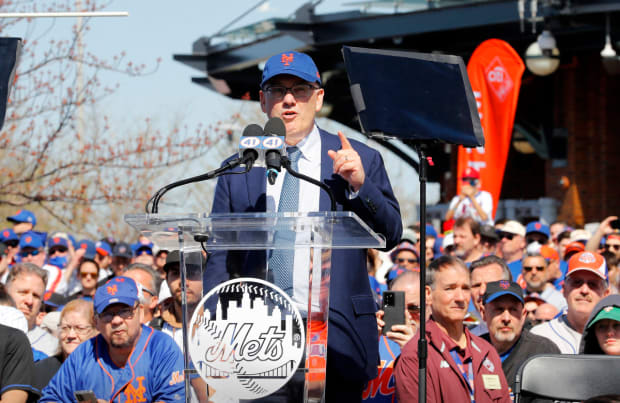
Jim McIsaac/Getty Images
It’s not easy to be the orange-haired stepchild in a market that also contains a 27-time champion. The Mets make it harder. Since Wilpon took control of the team in 1987, the club has tweeted more photos of dildos (1) than it has won titles (0).
Wilpon became sole owner in 2002; since then scarcely a year has gone by without a uniquely Metsy catastrophe. Some of the most notable: In ’05, righty Pedro Martínez has said, Wilpon’s son Jeff forced him to start a game despite a toe injury, because he wanted to sell tickets. (Jeff Wilpon has denied that allegation.) In ’07 the team led the division by seven games with 17 to play, then missed the playoffs. In ’09 VP of player development Tony Bernazard tore off his shirt and challenged the Double A Binghamton Mets to a fight. In ’13 the team asked older-women dating site Cougar Life for help promoting third baseman David Wright’s All-Star Game campaign before rescinding the request. In May ’18 Citi Field caught fire while the team was on a road trip. Four months later players fled the Fenway Park visitors dugout midgame to escape a rat.
In 2019, lefthander Jason Vargas threatened to fight a reporter. It took manager Mickey Callaway two press conferences to hone his apology for cursing at the same reporter. Five days later, the Mets honored two still-living players during the in memoriam portion of the 1969 team reunion. In their apology they misspelled the name of one of the men. Callaway was fired after the season; a year later, The Athletic reported that five women recounted sexual harassment by him. The team replaced him with Carlos Beltrán, then promptly fired him, too, after he was implicated in the Astros’ sign-stealing scandal.
In 2020, the team accidentally posted a video of GM Brodie Van Wagenen—a former agent Wilpon had installed atop his front office—ripping Manfred for his handling of that summer’s racial-justice protests. Wilpon’s statement castigating his top baseball official called him “Brody.”
In some ways, even under new ownership, they remain the Mets of yore. Cohen’s first GM, Jared Porter, was fired after ESPN reported that he had sent explicit, unwanted text messages to a female reporter; the man who replaced him, Zack Scott, was fired after he was arrested for allegedly driving under the influence after leaving a team fundraiser. (Scott was later acquitted of the charges.) A review of workplace culture conducted by law firm WilmerHale, hired in March 2021, led to the dismissal of the heads of the legal department and human resources that June.
In May 2021, the players invented a fictional hitting coach, Donnie Stevenson, and began attributing their successes to him; two days later, the team fired actual hitting coaches Chili Davis and Tom Slater. A few days after that, shortstop Francisco Lindor reportedly grabbed second baseman Jeff McNeil by the throat in the tunnel behind the dugout during an argument over defensive positioning. After the game, Lindor lied to reporters that the two had seen a rodent and discussed whether it was a rat or a raccoon. In August, amid a 9–19 stretch, Lindor, second baseman Javier Báez and outfielder Kevin Pillar began booing the fans back by flashing a thumbs-down whenever they succeeded—which was not often. The team finished 77–85 and missed the playoffs for the fifth straight year.
This winter, the team’s reported first choice to replace Scott was former Nationals assistant GM Adam Cromie, a mergers and acquisitions lawyer in Pittsburgh who has been out of the game for half a decade. (Alderson eventually settled on Billy Eppler, who was the Angels’ GM from 2015 through ’20.) Alderson’s son, Bryn, heads the scouting department, putting some of his underlings in a potentially awkward position.
And the Mets’ relationship with the media remains uncomfortable at best. A spokesman listened in on an interview with Alderson, a 74-year-old Marine and Harvard Law School graduate in his 41st season in professional baseball. The team initially agreed to make several front-office staffers available for interviews for this story before rescinding that access, saying that Alderson could speak for them. The team also declined to make Cohen available, explaining that he was busy with what some Mets employees refer to as his “day job,” running Point72, his new hedge fund. A spokesperson did provide a statement from Cohen: “This isn’t the time for a victory lap as we need to stay focused on the rest of the season, but I couldn’t be more proud of the team and the energy of the fans at CitiField [sic] is electric.”
Certainly Cohen brings his own dysfunction. In addition to the insider trading, his firm has at least twice been the subject of grievances filed by female employees with the Connecticut Commission of Human Rights and Opportunities, and another woman sued Point72 for gender discrimination. (According to someone familiar with the situation, both grievances and the lawsuit have been settled for undisclosed terms. Point72 has denied all claims.) The bestselling Black Edge, by Sheelah Kolhatkar, which chronicles the downfall of SAC, paints a picture of a mercurial man who rose to the top of his industry by choosing which rules to follow. His image among baseball fans as an avuncular goofball in a half-zip, taking suggestions on Twitter to bring back Old Timers’ Day and throwing money around, has served to rewrite his legacy as a Wall Street villain. Indeed, in ’11, when Senator Chuck Grassley (R., Iowa) began complaining loudly that the SEC was letting SAC operate suspiciously, Cohen sent some of his executives to Grassley’s office to try to placate him. “Steve is very civic-minded,” Michael Sullivan, now Cohen’s chief of staff, told Grassley’s staffers, according to Kolhatkar. “He’s thinking about taking a stake in the New York Mets.”
So it’s hard to blame righty Chris Bassitt for the alarm he felt upon being traded to New York from the A’s in March. “It sounded like it was a mess,” he says. “Then I got to spring training and was like, ‘Oh, this isn’t like that at all.’ ”
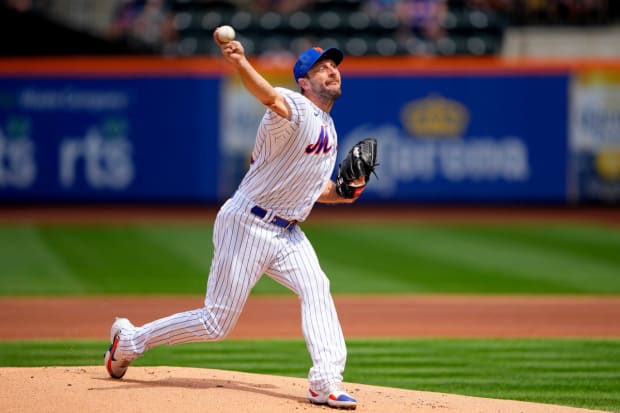
Gregory Fisher/USA TODAY Sports
Standing at his locker at Nationals Park on the afternoon of the trade deadline, Lindor rolls his eyes remembering last season’s absurdities. “There were so many different things last year,” he says. “It wasn’t a professional organization, I felt like.”
Lindor played 2021 under the weight of a 10-year, $341 million contract signed before he stepped onto the field in Queens. He had spent his entire career to that point in Cleveland, and he says he struggled to adapt to the expectations of New York.
This year’s group is different, he says: “Guys go about their business the right way—you ain’t gotta worry about it—and then once they’re done, they turn the page. Professional. I like that.” He adds, “A lot of guys got arbitration for the first time, or second or third. They got a little more money. They realize it’s not just the money. It’s Gotta win. So it’s a big mix of a lot of things.”
“Accountability,” says center fielder Brandon Nimmo.
“Leadership,” says first baseman Pete Alonso.
“Winning,” says reliever Tommy Hunter.
Most people around the team trace the change to the same place. Righty Taijuan Walker sums it up as well as anyone: “It starts with Buck.”
Buck Showalter, who in December replaced Luis Rojas as manager, was just a few days into his new job when he visited Citi Field for the first time. He ran into Alex Cohen, Steve’s wife.
“What do you think?” she asked him.
He briefly demurred, then waved at the blue walls. “It’s too dark,” he said. “And all these [inspirational] sayings can go.”
Nine months later, ensconced in his office, which he had redesigned so the bathroom door was around the corner from the entrance rather than the first thing you saw—”That’s not a good presentation”—he still shakes his head at the idea.
“I have never said, ‘Man, I became a better player because of something I read Winston Churchill say, or Aristotle,’ ” he says. “Oh wow, I’m supposed to try?” He says he wants to read only one saying: “Play better.”
Showalter likes to talk about “eliminating sympathetic ears.” His players are being paid more money than almost anyone on earth to play a kids’ game. The only time they should complain, he says, is if the checks bounce.
But Showalter is not quite the red-ass baseball lifer these lines would suggest. He mostly avoids the clubhouse, striding quickly through it with his head down when he needs to enter, because, he says, “That’s the players’ locker room.” He moved all the support staff out and had a large closet turned into a locker room for them, complete with a nearby bathroom so they did not need to traipse over to the bat kids’ area in towels and shower shoes. When the ballpark operations staff asked what they should do with all the equipment that had previously been stored there, Showalter shrugged. “Put it outside my office,” he said. “I don’t care.” So for months, the likely NL Manager of the Year squeezed past dozens of rubber bins on his way to work.
In July, when Alonso started to ask whether it would be O.K. to add a pool table to the clubhouse, Showalter did not let him finish his sentence before saying yes. In that first conversation with Alex Cohen, the skipper also mentioned the family room, where players’ partners and children hang out. It looked like it was waiting to host a meeting that could have been an email.
“Next thing I know, her interior designer is down here, like, half an hour later,” Showalter says. The new space boasts a magnetic chalkboard wall, balloons, miniature lockers, a floor piano mat, a painted road winding along the wood floor, a play food truck, four separate seating areas, a toddler area with multicolored rubber tiles and a plastic caterpillar tunnel, and eight stroller parking spaces.
Upon seeing it for the first time, righty—and father of three—Max Scherzer grinned. “My kids are never gonna watch me pitch again!” he said.
When players complained that the glass offices behind center field caused half an hour of glare during day games, Showalter called director of ballpark operations Sue Lucchi, who installed a film on the windows. He also eliminated assigned seating and dress codes on flights.
“If it’s important to the players, regardless of how trivial it is, it better be important to you,” Showalter says.
He also tries to influence what is important to them. He spent much of spring training drilling rules most of them had never considered and has spent much of the season reaping the benefits. For example: If an opponent was discussing appealing a play in which a runner left third base too early and there was another runner on base, Showalter said, the other runner should try to steal a base. If the opponent tried to throw him out, the team would no longer be able to appeal because the ball would’ve been put back into play.
In April, the Diamondbacks were considering appealing a sacrifice fly when infielder J.D. Davis (now with the Giants), standing on first, took off for second. Pitcher Oliver Peréz took a step toward second—negating the right to appeal—then threw to third. The run stood, and Davis was on second.
Showalter also tries to leaven the grind of a baseball season with witticisms delivered in his Florida drawl. Before a game earlier this month, he broke his clubhouse rule to ask players one by one, for no apparent reason, whether they had ever tried one of his favorite snacks. “He was just aghast that nobody eats boiled peanuts,” says reliever Trevor May.
In late July, Showalter felt it would be unhelpful to give his players the standard rah-rah speech before they faced NL Cy Young candidate Sandy Alcantara of the Marlins. “Listen,” he said instead. “We can’t beat this guy. He’s great. He’s probably gonna win every award. Let’s go have some fun and nobody get hurt and kind of take in how great he is. I don’t even know why we’re going out there. Just go listen to the anthem and have some fun.” The hitters howled with mock indignation.
That night, the Mets chased Alcantara after five innings and four runs and won 6–4.
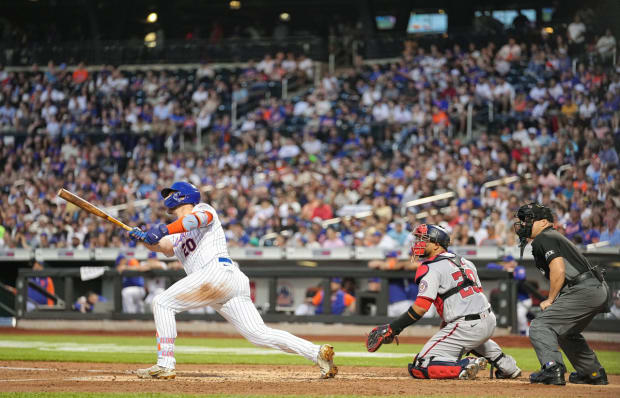
Erick W. Rasco/Sports Illustrated
During that same game, Alonso dove headfirst into first base, where he was called out and narrowly avoided hurting himself. Lindor was waiting for him when he returned to the dugout.
“Hey,” he said. “Appreciate the effort, but . . . ”
Lindor did not say anything else. He did not need to. Alonso got the message. So did anyone else who overheard: We play smart here.
Bassitt noticed and privately applauded. He worried when he arrived in New York that his new teammates did not share his emphasis on accountability. “I knew the names, but I didn’t know the personalities, so I didn’t know who could handle what,” he says. “Overall, I think, we have a locker room full of guys that like to be pushed, and that’s exciting. I think that’s honestly one of the biggest reasons why we’re good this year.”
The front office hoped to cultivate that environment with the acquisitions made last winter. The Mets let Báez, Pillar, righty Marcus Stroman and right fielder Michael Conforto walk in free agency, and spent a quarter of a billion dollars bringing in Scherzer, outfielder Starling Marte, third baseman Eduardo Escobar and outfielder Mark Canha, and traded for Bassitt.
“There's a reason that guys who go about their business professionally stick around,” says Nimmo. “There's a reason that they cost a little bit more.”
Showalter says, “Billy does a great job of understanding the sixth tool,” referring to makeup. He adds, “And you’re able to take somebody kind of on the fence and put him in there, and because peer pressure takes over, you’re like, Wow, that guy may not be the same guy we saw last year. There’s sometimes addition by subtraction.”
Often leading the professionalism parade is Scherzer. The 38-year-old righthander encourages his teammates to come up to him in the moments following his outings and tell him what they saw. “This game will find any little situation to beat you with,” Scherzer says, “and you can lose ballgames if you don’t think of everything.” This idea has taken hold; the Mets’ starting pitchers now dissect one another’s appearances in the dugout during games. “The best part is it’s not just one guy,” Bassitt says. “We have five veteran pitchers. So every pitcher is basically licking their chops. That’s the funniest part about the whole thing: It’s not, like, Max and four rookies, where Max is the guy, so we’re all basically looking at Max and Jake [deGrom] and those guys and saying, like, ‘Please mess up so we can jump down your throat.’ ”
Scherzer is the only member of the team who has won a World Series, so his word carries even more weight than his contract (three years, $130 million; the largest average annual value ever for a pitcher) or his career (eight All-Star selections, three Cy Young awards) might suggest.
“To be quite honest with you, I don’t know what it takes” to win a championship, Bassitt says. So when Scherzer told him that even as his body grows sore down the stretch, he should throw his Day 2 bullpen on Day 2 rather than pushing it back to Day 3, Bassitt listened.
“We’re not trying to play until the end of September,” Bassitt says. “We’re trying to play until November.”
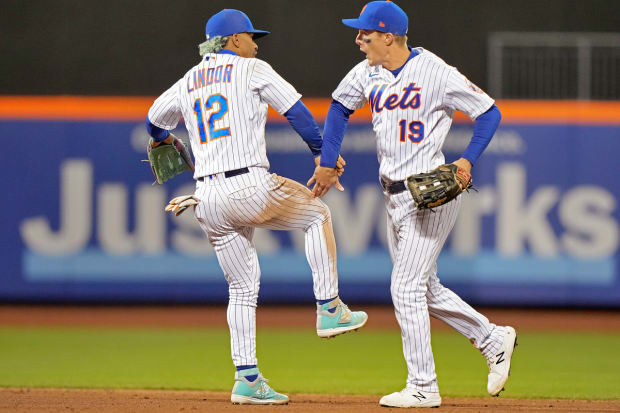
Erick W. Rasco/Sports Illustrated
When the Mets returned from a 10-game, three-city West Coast swing in June, a gift was waiting for them: a pitching machine made by the Canadian company Trajekt that can replicate any pitcher’s exact delivery and repertoire. The device, which six other major league clubs also own, costs in the low six figures annually for a three-year license. The team had already expanded the batting cage, offered bat fittings, begun measuring players’ grip strength and installed devices in the weight room to track players’ explosiveness and identify when they need to rest.
“Anything that has value to make us better they’re all for,” says Nimmo. “It’s a business, and sometimes you can go out and buy the better equipment, and it makes working a little bit easier.”
In his first meeting with the team, Nimmo says, Cohen said, “We want you to enjoy being here. If you were to leave here, we want you to say good things about this place, and what we've heard to this point is sometimes people leave and they go, ‘Don't [go there].’” Lindor says he speaks weekly to Cohen.
This season, Lucchi and her staff installed mounts in the bullpen to hold the team’s Edgertronic and Trackman devices. In past years, staffers would set them up on tripods, giving them an extra task and, crucially, meaning that the measurements were being taken from slightly different positions during each session.
“Then the data starts to come into question,” says pitching coach Jeremy Hefner. He also raves about the “human capital”—where he once spent mornings combing through data and afternoons working with players, he can now ask any of 20 analytics staffers to run reports for him. The front office increased to 57 people in this spring from 32 in 2020 (before the pandemic hit).
One popular change has been upgrading the facility in which the hitters and pitchers hold their pregame meetings. The team added stadium seating and two televisions, one for video and one for reports, plus a blue-and-orange barber pole outdoors that lights up when the room is in use.
“That’s not hardware or software,” says Alderson. “But it’s creating an environment in which professional communication is appreciated. It used to be we’d meet in the lunchroom and it’d be a bunch of grab-ass and what have you. This is all business.”

A few times a year, the Mets whine about their broadcasters. Gary Cohen, Keith Hernandez and Ron Darling work for SNY, the regional network that is majority-owned by the Wilpons, but the crew criticizes the players as lustily as any local columnist.
They will cheerfully spend innings berating a defender for being out of position on the wheel play or grumbling about a pitcher’s slow pace. Their candor endears them to fans. It often has the opposite effect on the players, who cannot understand why three men who fly on the team plane seem not to root for the team. They complain quietly, and sometimes not so quietly.
Showalter addressed this issue early in the season. “They’re not our enemy,” he says. “I said, ‘Guys, you control that.’ ” He told them one of his favorite stories, that of David Cone, whom he managed with the 1995 Yankees. After a stretch of two or three bad starts, Showalter recalled, “they were booing his ass off the mound” and someone asked him if the reaction made him upset. “No,” Cone said. “That’s my fault. They’re waiting to embrace me. That’s up to me.”
Remarkably, there have been no fights with the broadcasters this season. But that’s not because of Showalter’s speech, nor is it because the team is playing well; the players still dislike criticism, and the Mets’ poet laureates have still found plenty to criticize. No, the reason for the harmony is much simpler: Showalter muted all the televisions in the clubhouse.
Sometimes it’s not about attitude or money or personnel. Sometimes it’s about turning down the noise.
Editors’ note, Sept. 16 at 4:27 p.m. ET: An earlier version of this story incorrectly stated that SNY is majority-owned by the Mets. In fact, SNY is majority-owned by the Wilpons, not by the team.







